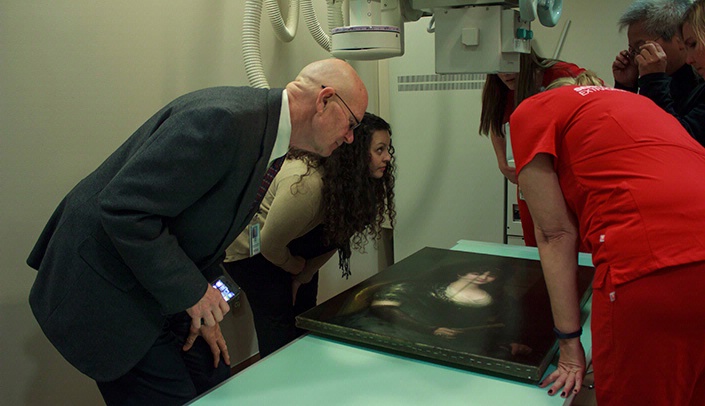Two oil paintings from the Joslyn Art Museum by renowned artists of the 18th and 19th centuries have been unlikely patients at UNMC.
James Temme, associate professor and director of the radiation science technology division in UNMC’s College of Allied Health Professions, was called on last year by the Joslyn and the Nebraska State Historical Society’s Gerald Ford Conservation Center to help with conservation efforts. They wanted the paintings X-rayed to allow them to learn more about the artists’ techniques and the condition beneath the surface of these well-known artworks.
The first patient, “The Pearl of Venice,” by Thomas Moran, dated 1899, has long been a favorite not only of Joslyn visitors, but of the artist himself, who considered it his finest view of the city. The X-ray revealed Moran’s underdrawing, and was part of a behind-the-scene conservation exhibit at Joslyn.
The second patient, “Marquesa de Fontana,” was painted around 1800 by Spanish court painter Francisco de Goya, and X-rayed in October 2015. Kenneth Be, paintings conservator at the Ford Center, said radiographic imaging allows him to see more details than he can with the naked eye or even a microscope. Art restoration was the topic of one of UNMC’s Science Cafes.
“It is only with this kind of imaging that one can truly know certain aspects about a painting hidden beneath the surface, such as some condition problems and clues to the painter’s studio technique,” Be said.
Kenneth Be and James Temme view the radiograph and see underneath the top layer of paint – hoping to reveal what the artist originally saw more than 115 years ago.
“With the X-ray image,” he said, “I found that the Moran painting was in near perfect condition, but there was a slight revision. The artist had started to render the prow of a boat in the lower right corner. The radiography shows some of the painted detail and figures standing in it. Now it’s just water.
“As for the Goya, much of the painting has been restored and there are areas that are difficult to study because of the restoration paint. Radiography will help us better understand the nature of parts of the original painting which are extant but not necessarily visible on the surface,” Be said.
Temme is proud that UNMC can provide such service to the art community. “The radiographic images of these paintings are works of art by themselves. The prints of these images could be displayed in anyone’s home or office.”
Web extras
Learn more about the Science Cafe.
Watch past podcasts of UNMC’s Science Cafe.
